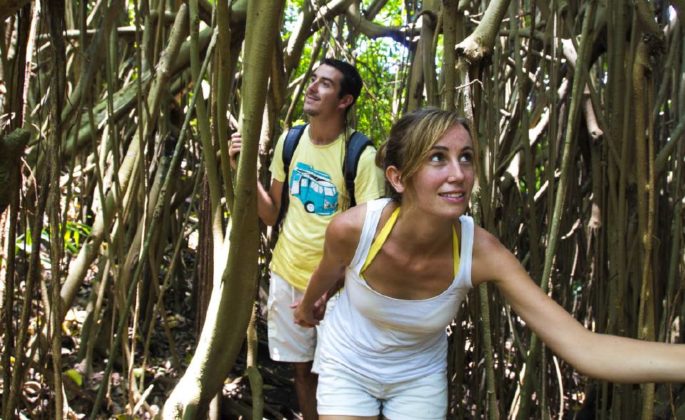Yvonne Eve Walus enjoyed a family holiday experiencing and relishing all that Vanuatu had to offer from new food adventures to a range of leisure activities.
Green bananas, orange papayas, red wild raspberries and white coconuts, husked and ‘smiling’ at passers-by with their triangular mouths. Welcome to the food market in Port Vila, the capital of Vanuatu.
Covered by a permanent canopy to shelter the produce from torrential rains and relentless sun, it’s easily one of the largest outdoor markets in Oceania.
We don’t bother to have breakfast before we catch a taxi from our hotel, and it turns out to be a wise decision, because the market has a cooked-meal section where you can feast on local cuisine. We choose fragrant parcels of lap lap, a traditional dish made with grated cassava and wild cabbage, cooked in coconut milk, and served wrapped in a banana leaf.
The children have a fabulous adventure sampling the new tastes (the raspberries are an instant hit, though opinion on coconut milk varies), measuring themselves against bunches of bananas, and taking photos of everything from palm fronds to cut flowers.
When it gets too hot to enjoy the dusty town centre, we retreat to the leafy lap of luxury that is Warwick Le Lagon holiday resort. Sipping non-alcoholic cocktails in the swimming pool (the children), and not-so non-alcoholic cocktails outside the pool (the parents), we let time slip by until lunch.
You’d be forgiven for assuming that Vanuatu, being an island, has a cuisine rich in locally-harvested fish and seafood. However, because of ocean currents, fishing is dangerous here, and so the staple meat in the traditional island diet oscillates between chicken and flying fox (bat).
Fortunately for the tourists, flying fox is optional, and so our lunch starts with a beautiful seafood medley compliments of the Wild Ginger Hotel restaurant. The chef goes out of his way to explain how he blends fresh local produce with French influences into fusion Asian dishes such as sushi and teppanyaki.
His char-grilled Santo beef is the most tender steak I’ve ever had, and it comes with a story: during the Second World War, a herd of Charolais cattle were set loose on the island of Espirto Santo to “mow the grass”. They have thrived there ever since, free range and organic and oh-so-delicious.
Free range and organic is certainly how we feel as we tackle the afternoon activities. Snorkelling in Erakor Lagoon (Le Lagon has boats and masks for hire) is a rewarding experience: we spot starfish bigger than our hands, slimy sea cucumbers and a multitude of silver-blue fish.
We come back pleasantly tired, just in time for a lesson in the local language: Bislama, a dialect evolved from English. Once we get the hang of the simplified grammar and phonetic spelling, it’s easy to understand – the phrase Buk blong mi means (the) book (that) belongs (to) me, in other words, my book.
That evening, our conversation is filled with gorgeous sounds like yumitu: (you me two, or the two of us) and mi wantem (I would like). When it transpires that my family wantem to kayak, I give it a go, but after a brief spell of trying to balance in the plastic husk, I let them paddle to the nearby island while I relax under the palm trees with a book – my idea of a good time.
I don’t get to have my way the next morning, though. It’s excursion time, and we’re going off the beaten track. While most people visit the Cascades Waterfall in Port Vila, Pascal from Vanuatu Ecotours takes us to an unspoiled wilderness deep into the heart of the island to see to a secret waterfall called Lololima.
En route we admire gigantic banyan trees, jump from the banks into the river, visit a lime grotto with tiny bats stuck to its roof, and pick wild raspberries (fresh off the bush they taste even better than those at the food market).
On our final day in Vanuatu, we catch a taxi to a ferry that transports us to Hideaway Island, a marine sanctuary where the snorkelling is even more spectacular than in Erakor Lagoon.
Hideaway also features a tourist attraction that’s a must: an underwater post box. We buy special waterproof postcards from the local shop, write on them in pencil, swim them out to the white buoy, and make a three-metre dive to post them into a genuine post box. We have the foresight to send one to ourselves, and it arrives shortly after we return home – a perfect reminder of a perfect holiday.




